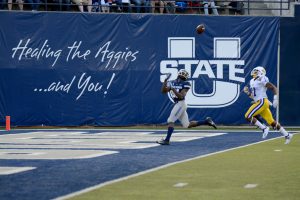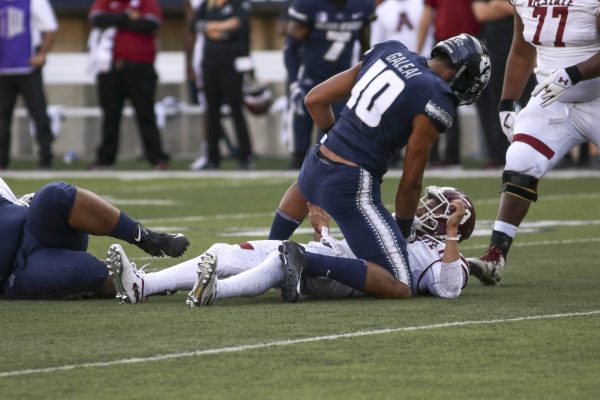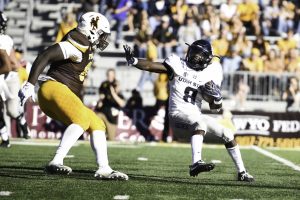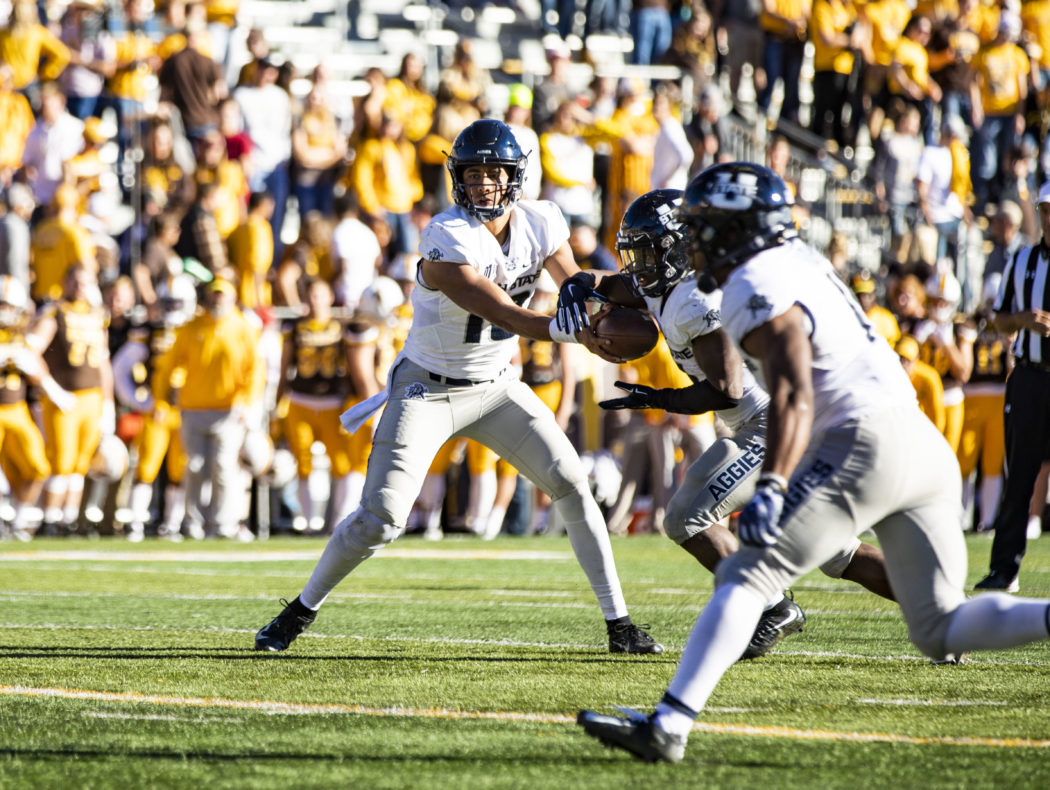Optimistic and Pessimistic predictions for USU Football
On a recent episode of The Statesman Sports Desk podcast, I talked about some of my optimistic and pessimistic predictions for the upcoming 2019 season of Utah State football. The next 2,000 words or so are my written expression of several of those along with a few extra. I wouldn’t say I’d hold myself to each of these predictions, as several are exaggerated somewhat to fit the purpose of being notably optimistic or significantly pessimistic. But in so being slightly over-the-top, they fulfill the purpose of illustrating my thoughts on the 2019 iteration of the Utah State football team.
As a matter of housekeeping, I’ll note that I will alternate optimistic and pessimistic predictions as we go along.
Jordan Love will struggle behind less capable offensive line
In the podcast, I alluded to my thoughts that Love may be getting over-hyped this offseason. There can be no doubt that the junior signal-caller deserves the attention he is getting from not just MW media, but national pundits as well after a stellar 2018 campaign wherein he rewrote the Aggie passing record books. That said, I fear some of that hype is not yet due.

Last season, USU quarterback, Jordan Love, set new program records for passing yards (3,567), passing touchdowns (32), and touchdowns responsible for (39) — Photo by Megan Nielsen
There are aspects to Love’s game that, if not improved, could prove to be the downfall of him and the Aggies in several games this season. The most potentially damming is Love’s general inability to handle the pass rush and remain composed in the pocket while under pressure.
When not facing the imminent threat of opposing pass rushers, Love is deadly accurate at every level with impeccable timing. It’s a beauty to behold. But when things don’t go according to plan, more often than not Love demonstrates himself incapable of saving the play. By no means does he consistently make horrible decisions that end in turnovers or huge losses of yards (in that regard he should be commended). But in so many situations, a simple increase in awareness would go a long way for such a small adjustment.
Last season, the issue of Love facing pressure rarely came up, with the offensive line showing itself to be one of the best in USU history. The one time it did, however, nearly ended in disaster. That singular example was against Wyoming — by far Love’s worst game. On the day, he went 12-of-28 with one interception and a pitiful 53 yards. Linemen set up shop in Love’s lap and even when there wasn’t pressure, its lingering effect could be seen in the numerous poor throws on the QB’s part.
This lack of success concerns me because (1) Love will have to face significantly better defenses this season and (2) he will do so with a much more inexperienced o-line. It may not wind up being as bad as I fear but expect some growing pains as Love works through one of his few remaining major weaknesses.
Receiving talent will not be a problem at all
Utah State lost a lot of receiving talent and production this offseason. Even more so is the fact that those athletes — Ron’Quavion Tarver, Jalen Green, Dax Raymond and the like — all fit extremely well with a vertical-minded QB in Love. They gave him a wide catch radius and created mismatches to exploit in numerous ways.
Now, Love has an almost entirely new cast of pass-catchers. And they look very different. From having three reliable targets who stand north of 6-foot-3, only one of Love’s primary core of returners tops 6-foot (tight end Carson Terrell — 6-foot-5).
The question of who will replace the 2,700-plus yards of lost receiving production is understandably a very concerning one. Not for me though. While I have yet to be confident that the new receiving core will be a great asset, I have little doubt that it won’t be an issue to worry about.

Savon Scarver caught just nine passes for 156 yards and a pair of TDs in 2018, but the All-American kick returner and Jet Award winner could play a key role in the passing game in 2019 — Photo by Megan Albrechtsen.
The Aggies have plenty of incoming receivers who will compete and ultimately contribute to the offense in 2019. Most prominent is University of Utah transfer Siaosi Mariner. In three seasons on the hill, Mariner caught 52 passes for 785 yards and four TDs, averaging 15.1 yards per reception (only one returning USU receiver tops that yards/reception mark).
Throw in a solid cadre of incoming high school standouts and JC transfers (I’m looking at you Derek Wright and Sean Carter) that are already on campus/participated in spring ball and the replacements is passable if not up to snuff relative to last year’s crew.
While several incoming players could factor in heavily, the returners are no slouches themselves. Jordan Nathan has potential to be a quality slot receiver that could fill the 581-yard, five TD hole left by Aaren Vaughns. I’m not particularly high on the receiving chops of Savon Scarver, but his top end speed and experience puts the All-American kick returner in prime position for a breakout year as a pass-catcher. If his hands improve, he could be a deadly weapon as a burner — something the Aggies lacked last season.
The tight end position could be a little weaker, but let’s face it, Dax Raymond was underutilized as a receiver, especially in the red zone (he had 3 career TDs) where Green, Tarver, or straight-up running the ball were prioritized over targeting TEs. I’m not concerned with having underwhelming pass-catching ends on the offense. Plus, Terrell, the top returning TE, is directly responsible for no less than three interceptions in the last two seasons.
The secondary has great pieces, but depth will hurt it
USU’s secondary will by no means be a major weakness. D.J. Williams will be a top-three DB in the conference, if not the best. Plus, Shaq Bond, Ja’Marcus Ingram and Cameron Haney have enough experience and talent to shore up any holes in the main crew of pass defenders. Past them, however, there are plenty of questions. And in this era of pass-happy offense, you can’t just sit on you’re base set of DBs. You need four or five corners and three to four safeties to have quality depth.
Last season, the secondary showed cracks due to an ever-increasing list of injuries but it held due to some decent depth, depth the team has yet to prove it possesses. If the primary cast holds, this may not end up being a problem. But if Williams misses a key game or a significant amount of games, it will be a problem and one teams will be eager to exploit.
Utah State will have the best front seven in the Mountain West

Utah State pass rushing specialist, Tipa Galeai led the Aggies and Mountain West in sacks (11) and was eighth overall in the nation in that regard in 2018 — Photo by Tim Carpenter
It can be argued with great legitimacy that the Aggies have not only the MW’s best linebacker in David Woodward, but also the best pass-rusher, Tipa Galeai. Utah State is the only team in the MW who will return two players that finished in the top ten in both sacks and tackles for loss (I’ll let you guess who those two players are).
In addition to the star-power of Woodward and Galeai, the Aggies return three key rotation players/starters on the D-line, Christopher ‘Unga, Devon Anderson and Fua Leilua. Incoming recruits and returning lettermen will bolster the remaining starting linebacker spots and overall rotation needs. And that’s not an empty hope or assumption. USU has four incoming three-star recruits at linebacker: Christian LaValle, A.J. Vongphachanh, Kaleo Neves and Jaylin Bannerman. The front seven is the position group least affected by outgoing 2018 seniors.
The only front line name Aggie fans may truly miss is the versatile and dynamic Jontrell Rocquemore, who slid into the front seven consistently throughout the year.
Still, an already decent amount of depth combined with star power is going to terrorize opposing offensive lines, running backs, and the poor QBs that will incur the wrath of the USU pass rush.
Gerold Bright won’t perform better than he did last year and will probably regress notably
Gerold Bright has had a distinct lack of expectations placed upon him this offseason, as opposed to Love, Scarver, Woodward, Galeai, etc. That may be for the best.
Despite rushing for 888 yards, with 13 total TDs, you’d think Bright wouldn’t go under the radar as he has managed to do so far. But as the de facto starter and most productive returning weapon for Love, he’s the logical choice to step into a much larger role.
Unfortunately, I don’t expect Bright to match his 2018 numbers. The only reason he may eclipse the 888 yards is because he’ll probably get more than the 141 rush attempts handed to him thanks to the departure of Darwin Thompson. Just don’t expect him to come close to the 6.3 yards per carry or the 13 scores.

Gerold Bright was second on the team in rush yards (888) and total TDs (13) in 2018, but struggled in close games Utah State played in — Photo by Megan Nielsen
My reasons for thinking he will struggle are pretty similar to those I presented regarding Love: a weaker offensive line and tougher schedule. It’s almost worse though. Last season Utah State struggled to move the ball on the ground against quality opponents whereas Love usually excelled versus tougher competition.
In USU’s four games that had a point differential under 10 points, Bright rushed for 130 yards and zero touchdowns on 32 carries, a rate of four yards per carry. Throw out just his three longest carries and he managed just 2.7 yards for each rush of the rock (Darwin Thompson’s 246 yards, four touchdowns and 4.8 yards per attempt look great, but throw out his 56-yard touchdown run against Wyoming and he only gained 3.8 yards).
Not on there is the issue of scheduling and supporting personnel, I just wasn’t as impressed with Bright as I was with Thompson. Bright lacks a dominant characteristic that separates him from the crowd. He’s not excessively shifty, speedy, powerful or versatile. He’s just OK at most of those. And while that worked a year ago, that’s not good enough to be a full-time back on a team with conference championship hopes.
Utah State will be the team to end BYU’s bowl eligibility
Knocking on wood a bit with this one, but every time I think about the Nov. 2 matchup against the Cougars, I can’t help but be confident the Aggies will retain The Old Wagon Wheel for the third year running and for a fourth time in the past five years.
BYU doesn’t look as poor as they did on paper a year ago, but on the table is the definite possibility that the Provo-ites will walk into Maverick Stadium without a win to their credit. I think they’ll have at least one or two, but a 1-6 record is highly realistic and would bring the sweet, sweet opportunity for Utah State to put the final nail in the coffin of BYU’s bowl hopes and dreams for 2019.
USU will not be in MW title contention late in the season
This is about as pessimistic as I can be and truthfully, I hope I’m as wrong as I was last year around this same time when I suggested that Matt Wells abandon the hurry-up offense.
My worries stem from basically all of the pessimistic predictions above and the factors feeding into them. Lesser O-line play leading to truncated effectiveness in the pass and run games, thin depth in the secondary and above all, a tougher schedule, make contention a much higher order than a season ago.
Perhaps the most concerning trend in my mind is the inability of recent Aggie squads to come away with wins in big games and, even more so, an inability to win close contests. The tougher schedule — which features road games at LSU, Wake Forest, San Diego State, Air Force and Fresno State with difficult home games like Boise State and Wyoming — is no small factor for my worries in this sector.
Since 2014, in games decided by less than 10 points, USU has a record of 3-14* (wins are over SUU in 2015 and Wyoming and Colorado State in 2018). That’s not the best indication of winning in toss-up games, but it shows that when their nose is put to the grindstone, the Aggies don’t thrive, they crumble.
Perhaps a more accurate measure would be Utah State’s record against teams that finished the season with a winning record. In that last two years, USU has all of two wins in that regard (and eight losses), Hawaii and North Texas. Let that sink in. The two best wins in two seasons where the Aggies went 17-9 with two bowl appearances are Hawaii and North Texas.
There’s hope that having Gary Andersen as coach could be a positive change that recent history. After all, at Utah State he was 11-12 in games of the aforementioned close-game criteria (9-8 excluding his first season) and went 6-6 his last two years in games against teams that finished above .500 (4-2 in 2012). Regardless, he has a tall hill to climb in reversing the Aggies’ troubling trend of losing close and important games.

